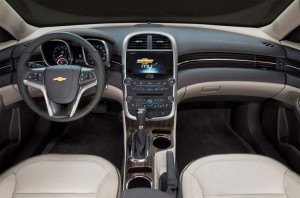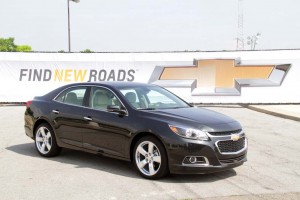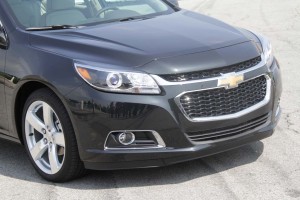General Motors has revealed an updated version of its 4-door Chevrolet Malibu, an unexpectedly rapid “refresh” of the midsize sedan that reflects the less than stellar reception it has received since its introduction last year.
Due to market this coming autumn, the 2014 will feature modest exterior updates and a number of more substantial changes to the interior – all reflecting feedback Chevy has received both from those who’ve bought the Malibu and from potential buyers that turned to the maker’s competitors, said Mark Reuss, president of GM’s North American operations.
Though the current version of the Malibu has been on the market for barely a year, development “was done before we went through bankruptcy,” Reuss noted during a conversation with reporters. The vehicle reflects the way things by GM’s old management team, he added, and “was not aggressive enough.”

The Malibu's all-new center stack includs cubbyholes for two cellphones. The rear seat, meanwhile, gets added room.
Such concerns were underscored by the rapid pace with which GM moved to update the midsize Malibu, one of the most important models in its entire line-up. The typical car in this segment can be expected to remain on the market for six to eight years, with a traditional, mid-cycle freshening – or refresh, in industry-speak – halfway through.
So, that normally would have meant waiting until as late as the 2015 or even the 2016 model-year before addressing some serious concerns. But GM’s new management team, insisted Reuss, was “not going to sit around” waiting until then.
In fact, some weaknesses with the sedan were apparent even before customers and so-called “rejecters” weighed in. While some of their concerns will have to be held for later – requiring massive updates to the underlying vehicle platform – GM was able to tackle several key issues:
- The exterior has been modestly tweaked, the most dramatic revisions involving the 2014 Chevrolet Malibu’s front fascia;
- The interior has undergone a more dramatic update including both an all-new center console and changes that have quite literally carved out more space for rear-seat passengers; and
- The refreshed Malibu will get a number of powertrain improvements designed to make it both more drivable and more fuel-efficient.
The base engine, a 2.5-liter inline-four, adopts direct injection and a 2-step intake system that helps it now yield 196 horsepower and 186 pound-feet of torque. But the big news here is the addition of a new Stop/Start system that briefly shuts down the engine, for example, instead of idling at a stoplight. The engine fires back up automatically when the driver’s foot lifts off the brake pedal. It’s the first use of the technology in a non-hybrid, 12-volt system at GM.
And Stop/Start, along with other improvements, help bump the midsize Malibu’s fuel economy to 23 City, 35 mpg Highway with the base engine.
The upgrade, 2.0-liter Turbo, meanwhile, now makes 295 lb-ft of wheel-spinning torque, a 14% increase over the 2013 Malibu that means the sedan can now launch from 0 to 60 in less than 6 seconds.
But what may be most important for family buyers, or those who like to travel with adult friends, is the added space in a rear seat that reviewers and shoppers alike had previously found cramped. Among other things, the backside of the front seats have been re-contoured to carve out another 1.25 inches of knee room.
GM launched the current version of the Chevrolet Malibu with high hopes of challenging the traditional segment leaders, notably the Toyota Camry and Honda Accord. But sales have lagged well behind those and other key models such as the hot-selling Ford Fusion and Nissan Altima sedans.
Perhaps more worrying for GM, the Malibu hasn’t been able to match the average transaction prices, or ATPs, of key competitors. The Volkswagen Passat, for example, was rolling off the showroom floor in April for $27,836, while Altima commanded $26,209, with Fusion at $26,305. By comparison, the midsize Chevy’s ATP – which factors in MSRP, discounts and options – lagged at $25,630, according to data from KBB.com.
Though GM is hopeful the 2014 update will boost both sales and transaction prices of the Chevrolet Malibu, not everyone is so upbeat. Analyst Jim Hall, of 2953 Analytics, suggests the refresh is “the best they could do with what they had,” but that it isn’t necessarily going to be able to match the best of the midsize competition.
For his part, GM President Reuss says the 2014 Malibu update should be seen as a sign that the Detroit maker is upping its game and won’t settle for “good enough” going forward. And if it finds the market unimpressed with a new GM offering, he promises, expect to see maker most fast on a fix, rather than waiting for the traditional timetable.



What is wrong with these “stylists”? They just transformed one kind of homely into another kind of ugly; the lowered lower grille makes the upper (now slot-nostril) look silly at best. Kinda looks like the hood wasn’t slammed hard enough. This ’14 makes the snout of my ’05 (homely but very dependable) Maxx look almost purty. Whatever happened to smooth styling? Geez GM…have you even glanced at the new Fusion? Proof that less fuss is more.
Sidney,
LOL! It’s got rental car written all over it. I remember when the Malibu was really a cool car. Check out the 1970 Malibu SS to see what I mean.
The previous model’s styling had it all: simplicity, compact dimension, great stance with rather long wheelbase, nimble and very German-looking!
The current model’s styling is overloaded with clutter, looks bloated and heavy. The “refresh” will make it even worse and won’t improve sales a bit. It’s a dud!
GM is just now realizing it has to compete with cars designed for 4-passenger comfort in every size range. Ford’s Focus and VW’s Jetta both have more rear legroom than the Cruze (or the Malibu!).
Perception is reality for most people. I personally did not think the current model Malibu was a bad design but the perception is that Ford’s new products which do a poor job of copying the Aston models, was more hip.
In the marketplace perception and marketing are what drive sales, no necessarily good engineering or quality designs and styling. Styling is totally subjective and I have to wonder what meds some of these designers are using…
What some folks love you couldn’t pay me to drive but they often win awards for being “innovative”, i.e. absurd or outrageous. Poor sales usually confirm the poor styling.
How many “slots” are enough on that nose? Looks like the hood is still open! And when will we realize that the 1990s upward looping Lexus interior center stack is soooo dated? I thought the silvery plastic trim went out with Hyundai around 2004!!
Suggest that the Malibu team talk with the new Impala team!